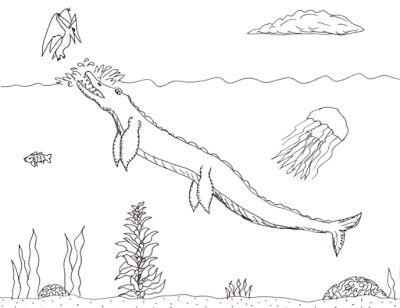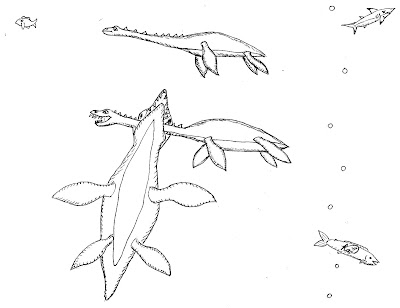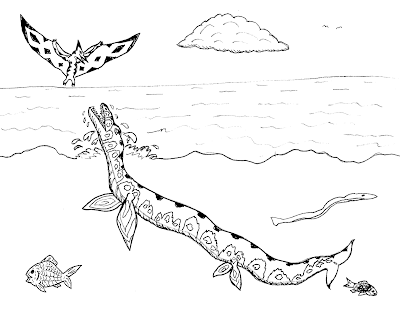This is a free coloring page blog. Click on the category buttons up top and scroll down the drop down menu to see hundreds of free and printable coloring pages. Scroll down the blog page and you can read the most recent posts. Scroll down and click on "Older Posts" and you can see all my posts about paleontology, religion, Fantasy, Mythology, Circus, Animaals, and Transportation.
Today's post is about Marine Reptiles. I am explaining briefly to help YOU the reader not be as confused as I once was about the different marine reptiles. All these are older drawings so they are somewhere on the Paleontology list.
First you should remember or learn that the dinosaurs and these marine reptiles lived at the same time. That was the Mesozoic Era 250 million - 65 million years ago. The Mesozoic Era is divided into three periods: First was the Triassic Period. The middle period was the Jurassic Period. The last period was the Cretaceous Period.
You also need to know that these ancient marine reptiles were NOT swimming dinosaurs. They were marine reptiles. (There WERE swimming dinosaurs, like Spinosaurs, but they are a different evolutionary branch.)
Ichthyosaurus with horizontal wave stripes
(There is not a printable version of the drawing like this.
I did add some background with details and it is seen down below.)
(There is not a printable version of the drawing like this.
I did add some background with details and it is seen down below.)
Mary Anning found the first know marine reptile. It was an Ichthyosaur. It was from the Jurassic Period and found by her and her brother on the Jurassic Coast of England near Lyme Regis. At first people called it a croc or crocodile. But it was not a crocodile. Like all marine reptiles, it breathed air. Although the Ichthyosaurs looked a lot like a fish. . . or maybe a dolphin. But it was a reptile. There is also evidence that it and many ancient marine reptiles did not lay eggs. They had live birth in the sea. Some species of Ichthyosaur, in the Triassic Period, grew to be 70 feet or 21 meters long.
Plesiosaurus surfacing
Plesiosaurs were the long neck marine reptiles. The purported, but not proven Loch Ness Monster would have to be one of these. Some Plesiosaurs had very long necks and some had medium length necks. Other Plesiosaurs had very short necks and they are called Pliosaurs. Some long neck Plesiosaurs, like Elasmosaurus, were around 33 feet or 10 meters long. Mary Anning found the first near complete fossil skeleton of a Plesiosaur on the coast near her home in Lyme Regis, UK.
Liopleurodon in shallow Sea
(This is a Pliosaur)
So this can be confusing, but a Pliosaur is a Plesiosaur with a very short neck. In fact they have practically no neck. Kind of like a hugely muscled man. Pliosaurs preyed on fish and smaller animals, but they certainly also preyed on Ichthyosaurs and the long neck Plesiosaurs. Liopleurodon is a well known Pliosaur. It was at least 23 feet or 7 meters long. Some partial remains of Pliosaurs indicate that some grew to be much larger.
Mosasaur Mother and Calf
Mosasurs seem to have replaced Pliosaurs during the Cretaceous Period as the top predator of the oceans of the world. Still, several long neck Plesiosaur and short neck Pliosaur species seem to have survived to the end of the Cretaceous Period. The asteroid that blasted the Yucatan Peninsula must have finished them off. Mosasurs were big beefy animals that had a long snake like tail. They seem to be related to Monitor lizards. One species of Mosasur, Tylosaurus, may have grown to 55 feet long. That is almost 17 meters long! It is possible that some Mosasaurs had a tail fluke, not just the long tail.
Below are some other drawings of Mesozoic Era marine reptiles.
Shonisaurus feeding
(This was one of the Ichthyosaur species that grew to be 70 feet or 21 meters long.}
Ichthyosaurus anningae hunting an Ammonite
(This was the first of Mary Anning's finds that was finally named after her.)
Ichthyosaur
Elasmosaurus Mother and Calf
(These are long neck Plesiosaurs.)
Plesiosaur with medium length Neck
(This is like the first Plesiosaur that was found by Mary Anning.)
Mosasaur after a Pteranoson
(Notice the tail fluke.)
To honor Mary Anning I drew a drawing of her with some of her finds. She and her brother found the first Ichthyosaur. She found the first Plesiosaur. It had a medium length neck. And Mary found the first Pterosaur or flying reptile that was not found in Germany. It was named Didelphodon.
We are going to the United Kingdom in a few months and we are staying a few days in Lyme Regis to see where Mary did her amazing work of fossil finding. (Plus we want to go fossil hunting too.)
It is sad that Mary Anning got so little recognition and so little financial reward for her amazing discoveries and her contributions to Science. The Icthyosaur species named after her was only named in 2015. Paleontologists examined a bunch of what were thought to be the same species of Ichthyosaur and discovered that several of them were unique and needed to be their own species. One of the new individuals of the new species was actually one of the Ichtyosaurs that Mary Anning had found near her home. So they named the new species after Mary. It is great that finally Mary Anning has a species named after her!
Mary Anning and 3 species She Discovered
I wrote quite a lot more about Mary Anning in previous posts. Just scroll down and
click on the "Older Posts" button and you should be able to find those two entries.
Belemnite about to be eaten by a Plesiosaur
Pteranodon fishing over a Tylosaurus
Pteranodon evading Tylosaurus
Tylosaurus with Large Scales
Tylosaurus with Ammoites
Tylosaurus with snake-like Tail
Tylosaurus with Tail Fluke
I wrote quite a lot more about Mary Anning in previous posts. Just scroll down and
click on the "Older Posts" button and you should be able to find those two entries.
Belemnite about to be eaten by a Plesiosaur
Kronosaurus hunting Plesiosaurs
(We saw the original fossil of this Kronosaurus at the Harvard Museum in Boston.
Kronosaurus was a 40 foot or 12 meter long Pliosaur. In this drawing the Pliosaur is
hunting its cousins, the long neck Plesiosaurs.)
Plesiosaurus macrocephalus hunting a fish
Pteranodon evading Tylosaurus
Tylosaurus with Large Scales
Tylosaurus with Ammoites
Tylosaurus with snake-like Tail
Tylosaurus with Tail Fluke




















No comments:
Post a Comment